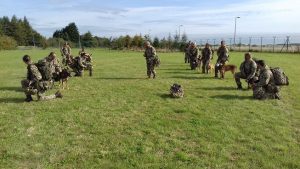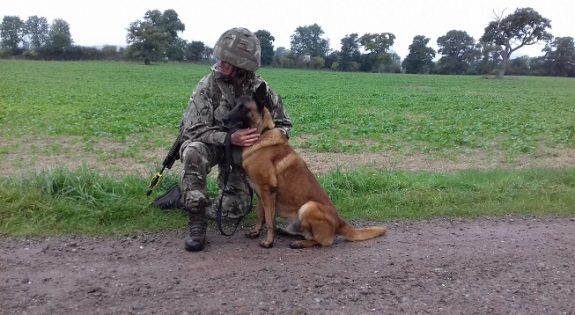News
February 16th 2018
A focus on: 101 Military Working Dog Squadron
101 Military Working Dog Squadron (MWD Sqn) is a reserve component of 1st Military Working Dog Regiment, Royal Army Veterinary Corps, and provides an exciting opportunity for reservists to train to be a dog handler or develop their veterinary skills in a military environment.
The unit based in North Luffenham, has 112 reservists on its books who are each training to play an important role in supporting operational tasks such as the detection of improvised explosive devices, counter insurgency operations and providing assistance in searching buildings, vehicles and key routes.
Military working dogs and dog handlers have been an important part of the Army for many years.

SSgt Luke Jones
However, it was only in 2015 that a reserve Sqn was introduced allowing reservists to deploy on worldwide operations.
An Army Reservist’s training is varied to allow individuals to gain a rounded skillset including the ability to work as a team, lead a group and think on their feet.
In September this year, 25 reservists from 101 MWD Sqn deployed on their annual two-week training exercise to the Yorkshire Dales seeing attendees take part in adventure training and study the battle craft syllabus.
The adventure training aspect of the programme allowed reservists to hone their navigational skills whilst hill walking, test out their map reading abilities using route cards and compass aids, and test their confidence by completing a mountain bike trail.
One of the reservists to take part in the annual training exercise was Warrant Officer Class Two Darren Garratt, aged 45, who in his civilian life works as an Emergency Medical Technician.
He explained: “The adventure training allowed everybody to get to know each other and build the Sqn’s cohesion even more.
“The instructors recognised the various levels of experience and skill in the reserves taking part and tried to adjust the programme to suit everyone’s needs.”
The battlefield training allowed the reservists to spend four days revising basic soldiering techniques including section battle drills and refreshing their infantry skills.

Troops and MWD waiting for Chinook
Darren continued: “The battle craft activities were great preparation for our final task. We heard the unmistakable sound of the Chinook helicopter rotor blades approaching, and the excitement on everyone’s faces was plain to see. As our adrenaline began to pump we reassured our canine colleagues and the Chinook landed in front of us. The ramp came down and after receiving a thumbs up from the crew we boarded the flight to Nescliffe Training Area for the final four day exercise that was focused around completing dog patrols in a forward operating base.
“The exercise saw us encounter friendly and enemy forces and actors playing members of the local community. The management fell to the reserves with some people assuming more responsibility than others and being able to use their initiative to achieve the best results from the exercise. We bonded well and learnt from each other’s strengths. Where mistakes were made we learnt from these allowing us to gain confidence in a controlled environment.”
101 MWD Sqn’s annual training exercise was a success and gave everyone involved a chance to continue to develop their military skills and trade dog handling techniques.
"As our adrenaline began to pump we reassured our canine colleagues and the Chinook landed in front of us."

